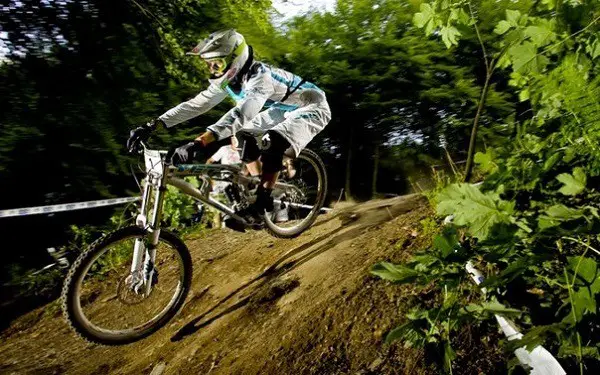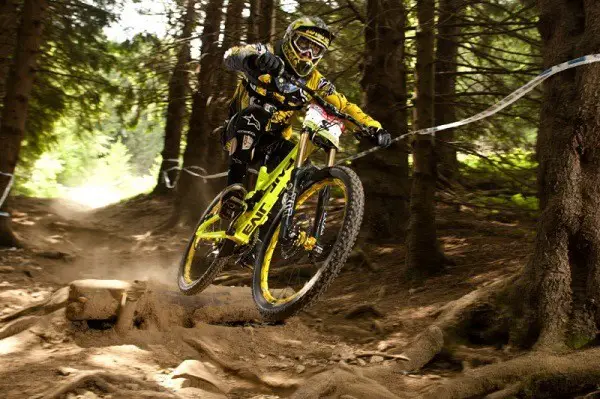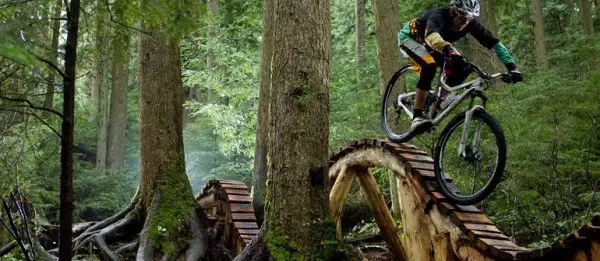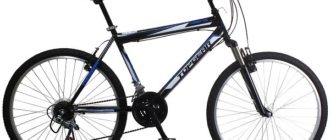“To take risks is to jump off a cliff, spreading one’s wings in flight.” (Ray Bradbury)
As many cyclists as there are styles of riding. Someone prefers speed, someone gives a leisurely and floppy ride with stops for selfies, well, the third does not bake bread, and served off-road, dizzying maneuvers on the verge of reaction and steep jumps. As you have probably already realized, today we are going to talk about this style of skiing, such as freeride, which originated in the early 80’s in the United States.
On what is freeride, what are its varieties, the essence of the discipline, what should be able to bike and, of course, what should be a bike for freeride – this and many other things will be discussed in this article.
What is freeride biking
In the classic sense of the word freeride is to pass complex trails of natural and man-made origin with jumps, overcoming obstacles and other challenges. It is clear that for a successful and, most importantly – safe – passing the route requires certain skills and proper physical training of the cyclist. But even the most super-professional would find it extremely difficult to ride a bicycle which is not prepared for it. Accordingly, for freeride you also need an appropriate machine.
What is freeride on a bicycle? The word “freeride” means free riding, that is riding without rules. But in fact, there are still rules: the cyclist must reach the finish line in one piece. Competitions take place in all kinds of weather. Therefore, freerider’s constant companions are: dirt, dust, water splashes, stones flying from under wheels, etc.
Freeride competitions are most often sponsored by the manufacturers of mountain bikes and related equipment. They are interested in demonstrating the capabilities of their products.
Types of freeride biking
A professional freerider successfully overcomes cliffs, descends winding paths, jumps over rocks, crosses high grass and leaves other obstacles behind. These are all the delights of freeride. You have to train hard for months to be successful. But it’s worth it.
A true freerider experiences a lot of sensations while riding the difficult routes on the bike. The height of the jump, the feeling of flight, the radius of the turn – the athlete feels all this on the verge of intuition. Accordingly, without the appropriate training here can not do without. Exactly as well as without a special bike. We’ll talk about it later, but now let’s analyze the classification of freeride. So, there are two big groups:
- Classic freeride.
- Light versions.
Light freeride does not require the cyclist to have serious physical training. There are no sharp breaks, long descents with stones and dirt, and steep trails. In fact, the tracks for the light version are a primitive model of the roads designed for professional freeride riders. The descents are more gentle, if they are lined with stones, they are small and in insignificant quantity. There may be an artificial structure as a natural descent. There are no speed limits in light freeride, so even a beginner can feel all the charms of this style of riding.
Substrates
If the classic freeride exists in a single instance, there are many more lightweight versions. A separate category of bicycles is used for each subspecies. Initially, these were regular suspensions, but over time the designs have undergone minor changes. Let us consider the subspecies (lighter versions) of freeride in more detail:
- Dropping. Jumping from flat surfaces, which do not necessarily have to be horizontal. Unlike ski jumping, there is no flying out. In fact, there is a controlled fall, not a take-off.
- Dert Jumping. Dart jumping. Today, it is quite an independent discipline. Athletes perform unrealistic tricks on limited sections. The key figure – the springboard. But small dropkicks can also occur.
- Urban Freeride. It is also called a straight. Basically, it is a combination of extreme mountain off-roading and urban traffic. Athletes use the urban landscape for an extreme experience: jumping down flights of stairs, performing tricks while riding and adapting the classic freeride to the urban landscape.
- Norshoring. This is a free riding on bridges and various structures made of wood. This style of skiing appeared quite unusually: originally, wooden structures helped to overcome the difficult areas on the trails (for example, a log could be blocked over the ditch). Today, this style of skiing build entire cities out of wood.
- Slopestyle. A relatively new discipline in freeride, implying the performance of a bunch of tricks on the most complex sections of a number of figures.
- Enduro. Basically, this is freeride on the minimum. Perceived more like extreme cross country.
In fact, the bikes for each of the disciplines have similar characteristics. Models differ slightly and their features are due to the specifics of this or that variety.
Characteristics of a bicycle for freeride
Since freeride became a separate sport discipline, they began to impose special requirements on the bikes. In fact, it is a separate kind of a mountain bike, but with some design features. A freeride bike is something in between MTB and downhill. The key features include:
- strengthened durability;
- lightweight;
- reinforced cushioning;
- powerful brakes;
- tires with a wide profile.
The importance of the first indicator cannot be overestimated. When riding on difficult and dangerous trails, the bike, along with the rider, experiences enormous loads. For this reason, the strength of the frame here is much higher than in the average mountain bike, because the safety of the cyclist is at stake.
Durability is strength, but no less important indicator is the weight of the bike to facilitate the passage of difficult routes. Modern manufacturers produce models made of lightweight alloys, which can reduce the weight to 14-15 kg, without losing strength.
Freeride is impossible to imagine without jumps, so the bikes are equipped not only with front, but also with rear shock absorbers. Here it should be noted that the amplitude stroke of shock absorbers (about 7 inches) significantly smoothes the shock loads.
And, certainly, the braking system. It is necessary to pay separate attention to this mechanism, because brakes are able to keep the situation on the track under control. In most cases, disc brakes are installed on both wheels.
As for tires, freeride-bicycles are equipped with wide-section toothed tires, which reliably grip the surface on tight turns and as well absorb rocks, branches and other bumps.
Cyclist requirements
Physical fitness and safety are our everything. And if power qualities are a purely individual development, the equipment deserves separate attention, because human health and life depend on its complete set and reliability. Therefore, right after buying a freeride bike, you should equip yourself with a reliable protection:
- Helmet. The freeride model differs from the standard equipment. In addition to head protection, part of the product reliably covers the chin, and also prevents accidental injuries to the face.
- Neck protection. No one is safe from a fall from a bike. Neck injury is a serious injury that can lead to adverse consequences. Therefore, it is worth taking care of the protection of the neck department.
- Shell. It fits under the outer clothing and protects the chest and spine from accidental injury.
- Knee pads and elbow pads. Elbow and knee joints are the most affected in a fall.
- Gloves. They do not only protect from fractures and dislocations, but also provide a reliable clutch of hands with a rudder, in fact, freeride is adrenaline release and, as consequence, increased sweating.
Many bicyclists wear special masks, preventing dust entering your face and airways. And, of course, goggles – they should reliably cover your eyes, but at the same time not to reduce visibility.
Safety rules
Freeride freeride, but you should also think about your life and health. Therefore, when practicing extreme sport, you should keep to a certain boundary, crossing which is impossible. Freeride is connected with the danger and belongs to the most traumatic discipline. The most common injuries include:
- concussion due to a severe blow to the head;
- fracture of the cervical spine;
- damage to joints.
It is necessary to concentrate on one point concerning the cyclist’s equipment. Remember that you can not reuse the helmet that has suffered a blow. You may not notice the micro-crack, and the next time it will not withstand even a minor blow.
That’s why it’s worthwhile to remind yourself about the necessity of equipment. Even if you’re only thinking of “free riding”, first of all buy protection, and then choose a bike.
Popular models
Bicycle freeride is an extreme discipline. Accordingly, the bike should be distinguished by the highest technical indicators. Wheels, brakes, frame, shock absorbers – all this and more should be designed so competently and technically correctly, so that the cyclist can overcome difficult routes and be confident in his safety. Among the most famous brands and brightest models are the following:
- Cannondale Scalpel 29ER Carbon 1. If you suddenly decide to buy a bike for freeride, you will certainly come across Cannondale products. Scalpel 29ER Carbon 1 bike is a unit not for wimps. The model is designed for professional athletes. It comes in two versions: BallisTec carbon and metal SmartFormed. Both bikes are notable for their low weight and powerful fork. For the Sram drivetrain, there are no roads it can’t handle.
- GT Fury Alloy 3.0. The company has been making mountain models since 1974. At one time it took part in the development of the first BMX bikes. The brake system of the model guarantees the necessary power on any route. Its reinforced fork with 200mm travel allows it to outrun the wind.
- Kona Operator. Perhaps this is the best model of mountain bike for a beginner freerider. It features laconic design and compact geometry. This is not a bad choice for those who do not want to bother much with technical maintenance bike. This is exactly what a great freeride bike should be: simple and reliable.
- Specialized Demo 8 II. If you need a fast and dynamic bike – pay attention to this model. With 200mm of travel, this fork is adjustable and can handle even the hardest shocks. This bike can be considered as a suitable model for downhill.
- Trek Slash 8. The model is equipped with an oversized fork, which provides ample cushioning. Expanded front axle noticeably increases the already excellent handling of the bike. With the rear shock absorber you practically do not feel the impact even from large stones.
Professional athletes note the good technical characteristics of MTB and Fully 4-Cross of the company “GHOST”. These bikes are distinguished by their ergonomic design, unsurpassed build quality and impressive design.
Conclusion
To summarize, we can say that freeride – is not just extreme skiing, but a special style and direction in the world of bicycles, which imply proper training. Those who have decided to seriously engage in such, should think about their safety and buy the necessary protection, which will save from serious injuries and unfortunate consequences.











